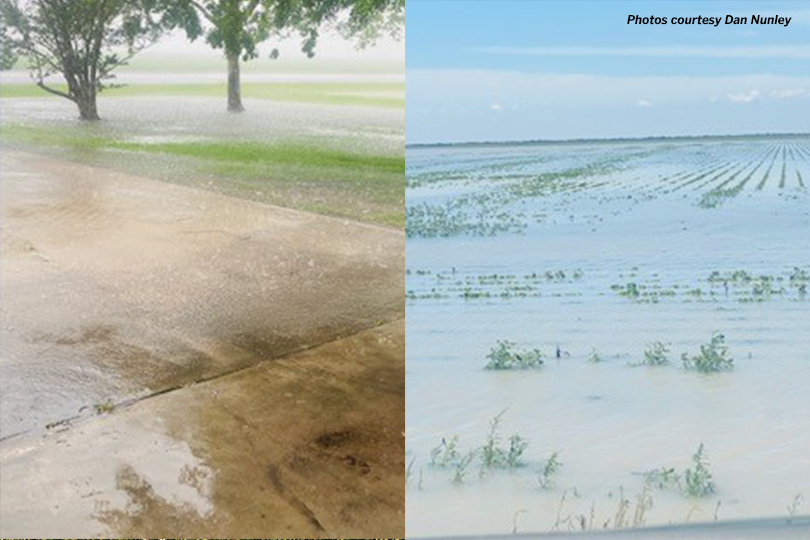By Jennifer Whitlock
Field Editor
Much of Texas is normally semi-arid and relies heavily on groundwater, so rain is generally welcomed. But Calhoun County farmer and rancher Dan Nunley is asking to spread out those rains a bit.
“We’ve received about 36 inches of rain since the last week of April, which is over half of our yearly average rainfall,” Nunley said in an interview with the Texas Farm Bureau Radio Network. “It’s made things quite difficult for us out here.”
The mosquito population has grown to what he called “horrendous” proportions, causing cattle herds across the area to become more active and restless. Nunley said the animals will walk downwind fighting the clouds of mosquitoes until they reach a fence line, then congregate in tight bunches to try to escape the biting pests.
However, Nunley said insect pressure is surprisingly light considering how wet things are. But cotton in poor-draining soil is straggling far behind normal growth patterns.
Cotton on well-drained soil will still require plant growth regulators to restrict growth and force fruiting. Otherwise, he noted, cotton plants would be six feet tall with no bolls on them.
“The cotton in the lower areas is starting to turn yellow. It’s had water standing on it for weeks, and it’ll be dormant until it dries out. It’ll take off, but it’s going to be late compared to the rest of the field,” Nunley, Calhoun County Farm Bureau president, said. “These are the low places in the field that you see when you drive by them and see the cotton just out in those low places, back down to 6 inches tall, where the rest if it is 2 foot tall.”
Right now, Southeast Texas sorghum is looking good despite the wet weather. The crop is pollinated and headed into the milk stage.
As with the cotton, insect problems are light. The intermittent rains followed by sunshine are keeping insect populations down, but Nunley said he expects to start seeing headworms or midges soon.
“We need for the rain to stop because we’re reaching the point where continuous rain will cause the seed to rot or sprout once it gets past the milk stage, and it’s approaching that quickly,” he said. “It’s hard to say right now, but it looks like it’s going to be a very good milo crop if the weather will straighten out from this point going forward.”
Corn crops are in a variety of conditions, from good to not-so-good, depending on when it was planted.
Early corn is in good condition, as well as that which was planted mid-season. But the later corn was planted during a dry spell and then received too much water all at once.
Those crops are yellowing from “wet feet” or root rot. The Southeast Texas farmer noted too much standing water causes roots to die and the corn stalks to fall over, and the same can occur in sorghum, too.
Heavy heads of grain and corn ears combined with strong wind and weak root bracing systems can lay a field of sorghum or corn flat, according to Nunley.
Just one week of dry weather would be beneficial for Nunley.
“All the rain has caused the herbicides to completely break down, and grass and weeds are common in pretty much all the crops right now,” he said. “The crops will have to dry out some before we could run a sprayer.”
For now, many Southeast Texas farmers are turning to aerial applicators to keep weeds and insects under control.
Nunley’s son-in-law recently used aerial application to apply insecticide to his cotton crops and was able to get in a round of herbicide between rains, so his cotton looks clean.
“We get two- or five-day breaks without rain and the son-in-law was able to get into the field that one little break in mid-May and get some herbicides out,” Nunley said. “He’s lucky he did, because it’s really paid off. Lots of other cotton farmers did not get that done and they are hurting.”
After ending 2020 about 20 inches behind on annual rainfall and carrying that trend into April, Nunley said the rain was a welcome sight.
But now he’s ready for the rain to move on for a bit.

